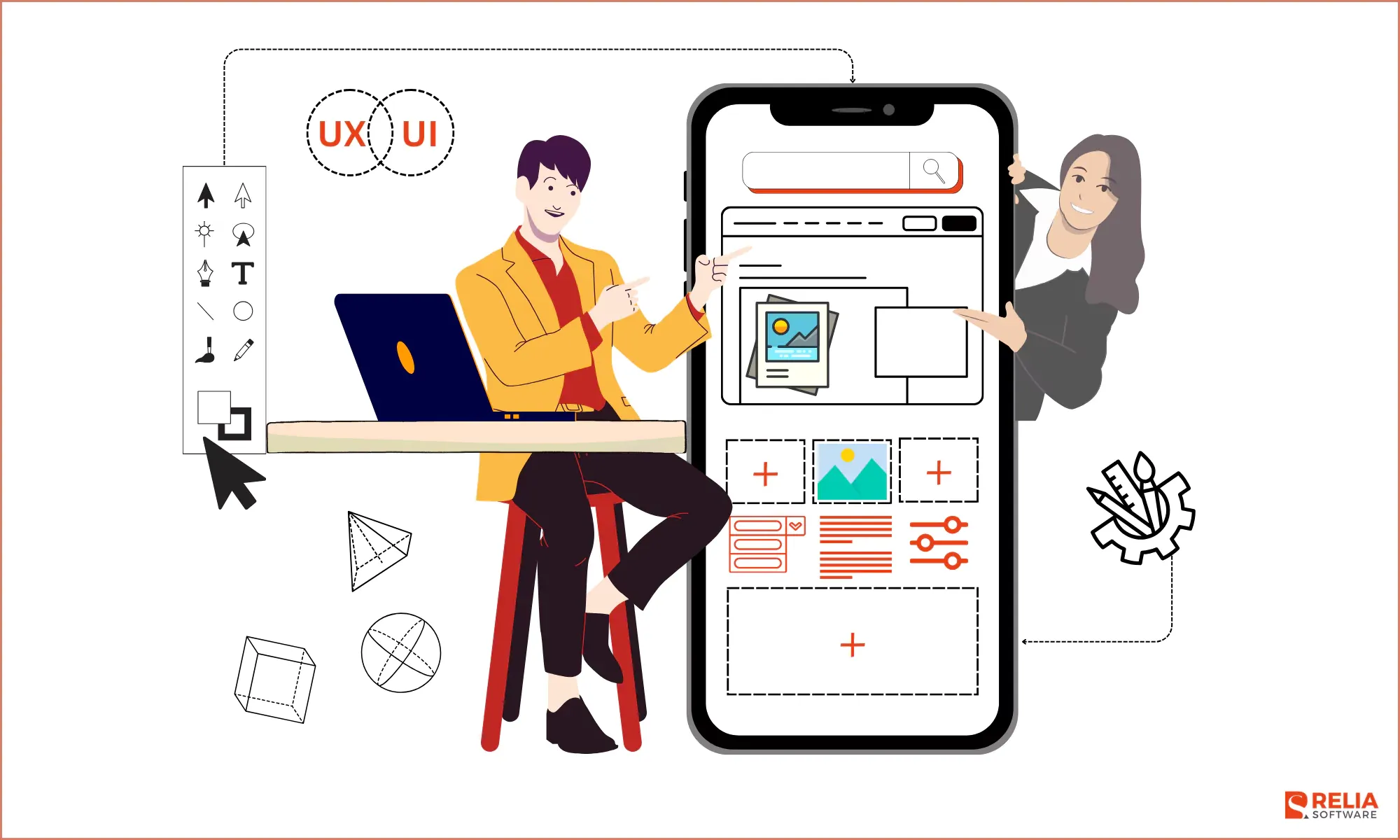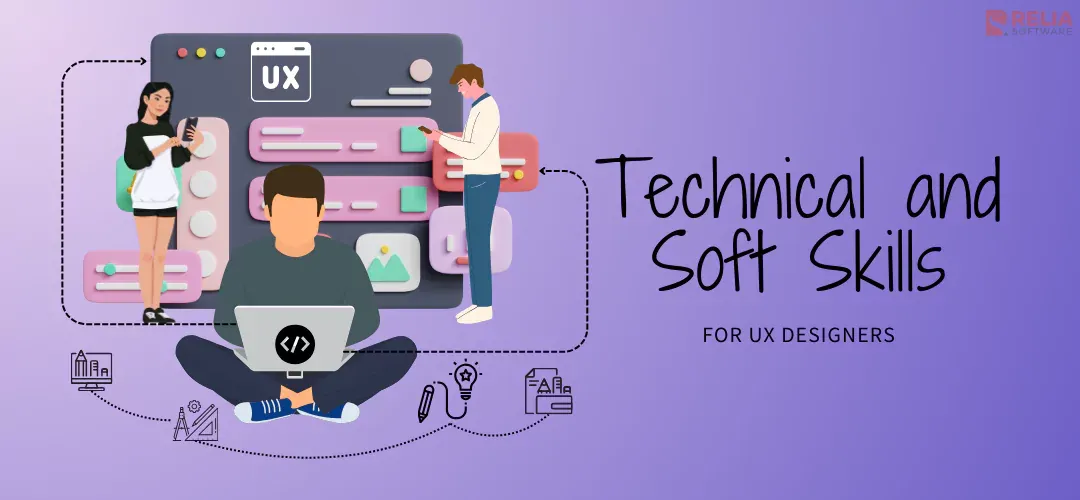UX designer skills are the unique soft and hard abilities that people can learn and improve in order to do well in UX design jobs. A lot of UX designers do things like code and bug fixing on the back end. In addition, they are in charge of front-end interactive design to make sure that users have a good time with the product.
As technology becomes more embedded into our daily lives, businesses realize the necessity of a smooth and engaging user experience. UX designers need a variety of talents to produce powerful and user-centric designs in this dynamic sector. This blog covers both the technical and soft skill abilities every UX designer requires.
How to Become a UX Designer?
These tech experts are in charge of both the parts of a digital product that you can see, like menus, pictures, and colors, and the parts that you can't see, like the code that makes an app or website responsive. They want to make the product as easy to use as possible by putting efficiency, usefulness, and ease of navigation first. Because they have to do two things, it is necessary to make sure they have a lot of skills for UX designers.
To be a UX designer, you should know how to use design tools well and be good at analyzing things. Also, they should know what users want and how to make goods that are given to them.
A degree in graphic arts, design for interaction, interaction between humans and computers, or a related area is the most important thing for a UX designer to have. They may also have a degree in engineering, business, or something else and have finished school to become certified in UX design.
Adobe Photoshop, Illustrator, InDesign, After Effects, and Dreamweaver are essential for UX designers to use. Props should also be possible with Axure, Sketch, and InVision.

>> You may want to know: How to Become A Computer Vision Engineer?
Essential Technical Skills for UX Designers
Research
UX designers must understand their audiences' needs and worldviews to succeed. UXmatters says this requires planning, conducting, and analyzing research from many approaches. User testing and analytical research skills help.
Wireframing
Wireframes are interface screen blueprints. Its major objective is to demonstrate functionality, not appearance. Wireframing defines page-to-page elements. It is grayscale and uses boxes and lines to incorporate all interface components for all interactions.
Prototyping
Designers test functionality via prototypes. They help designers match systems to consumers before building the final product. Designers can test website functionality and navigation with prototypes. After identifying issues, the UX designer may iterate until a design meets business and user goals. UX designers must prototype rapidly and efficiently.
Depending on the stage of development, you may utilize wireframes, low- or high-fidelity designs, mockups, or user flows. Define these terms.
-
A wireframe is a web page layout without visual design used for prioritizing user needs.
-
Test and feedback prototype: A sample or simulation of a finished product. Paper-based low-fidelity prototypes don't allow user interaction. Computer-based high-fidelity prototypes use mice and keyboards.
-
Mockup: A realistic graphic representation of a website or app.
-
User flow: A diagram of a product or service's user journey.
Interactive design requires familiarity with hands-on skills. You may start with pen and paper, thankfully. To learn the components, sketch wireframes, and user flows for a widely used app or site. Try paper prototyping with a pen and paper.
The Ability to Write for UX
UX writing is an important skill for UI/UX writers, and it's part of user experience skills because it means making content for websites, mobile apps, and software that is clear, concise, and interesting.
The main goal of UX writing is to help people find their way around an interface and make good use of it.
To get their point across, designers need to use clear, simple words that a lot of people can understand. They also need to know a lot about the user's wants, needs, and habits in order to write a copy that connects with the user and solves their problems.
In UX writing, consistency is important because designers need to use the same language, tone, and style to make the whole experience for the user feel like it's one.
Last but not least, designers need to work well with other team members like developers, content planners, and others to make sure that the copy fits into the interface in a way that meets the user's needs. It's a key skill for UX designers.
Skill in Visual Communication
UX designers need to be able to communicate visually in order to make systems that are both appealing to the eye and easy to use. UX designers must know the visual language because the design is graphic. Visual communication proficiency requires grasping ideas like:
-
Layout
-
Color
-
Typography
-
Icons
-
Images
-
Design theory
Using graphic design rules like font, color, and layout to make visual elements that get a message across is called visual communication. Designers need to be able to choose typefaces that are easy to read and make the interface look better.
A good knowledge of color theory is also important for them. This will help them use color successfully to communicate meaning and evoke emotions.
Visual communication skills that work focus on using more visual cues to help the user understand where to go next, how to find the information they need, and what other actions they can take instead of written directions.
Skill in Interaction Design
With interaction design, designers can make systems that are easy for people to use and keep them interested. To make digital platforms easier for people to use, interaction design involves making buttons, menus, navigation systems, and other interactive parts of a product more logical.
Today's successful digital products depend on interaction design that is easy for users to understand and use. This means that users can finish tasks with little effort. Sound, motion and physical room are all things that affect how a person interacts with a product. Focus on how users move through your site, how easy it is to find information, and how well the layout works. Designers who know how to do interaction design can make systems that are more interesting, simple, and useful for users.
Coding Skills
Coding skills aren't usually needed for UI/UX designers, but knowing the basics of it can be helpful. Coding languages like HTML, CSS, and JavaScript can be used by designers who know how to make prototypes and interactive designs of goods. This could help creators make prototypes of the product that are more like the real thing and can be interacted with.
Designers who know how to code can also work better with developers because they know what the technical needs and limits are for the project.
Information Architecture
Because it helps them organize and arrange information in a way that is easier for users to understand, information architecture is an important skill for UI/UX designers. Information architecture is the process of putting information in a way that makes sense to the user and helps them reach their goals and complete their jobs.
Before creators can make a good information architecture for a product, they need to know how people think about information and how they find and use it. They should be able to make navigation systems that are clear, simple, and have labels and groups that make sense.

Soft Skills for UX Designers
Companies recruiting UX designers focus on soft skills that are useful in varied work environments as well as technical ones. Knowing what to work on makes developing soft skills easier. Let's examine some essential soft skills for UX designers.
Active Listening
Since you'll spend a lot of time talking to your team, clients, and customers, UX design and research require active listening.
Your attention and communication abilities affect how well you comprehend consumer demands, feedback, and insights, which are crucial to producing meaningful products.
Empathy Skill
As a UX designer, you must put yourself in a user's shoes to comprehend their pain points. This makes user empathy essential for designers.
You may better help others when you grasp their problems and frustrations. Empathizing helps UX designers see issues from multiple angles and connect with users.
Curiosity & Perpetual Learning
User experience design evolves and expands. To become an outstanding designer, you must follow the industry's changes. Keep up with the latest developments and discover how to improve your user research, UX analytics, and testing for usability approaches.
Critical Thinking
Additionally, you require critical thinking. To develop a seamless design system, UX designers analyze, evaluate, study, observe, and reflect to make many cautious selections.
UI/UX designers need to be able to think analytically, which is part of their user interface design skills. To make smart design choices, you need to understand and study user behavior, feedback, and data.
To find out what users want and where they are having trouble, designers need to be able to gather and analyze data from many places, such as user testing, surveys, analytics tools, and comments from stakeholders. They should know how to read data and use it to make design decisions, like which features to add first or how to make the user experience better.
To make effective and up-to-date interfaces, designers should also be able to do competitive research and find out what the latest trends and best practices are in the industry.
How to Improve Your UX Design Skills?
Getting Online Degree
To get better at UX design, you should keep learning new things and practicing what you already know. Some things you can do to learn more about UX design concepts and methods are to take UX-focused courses, workshops, and tutorials.
Getting a degree online gives you the skills you need to start a job. The digital format of online programs gives students important hands-on experience. Getting qualifications from college or university can also help you get a job. But watch out for short-term schemes. Although it might be fun to learn UX for a week, it probably won't help you build a successful job.
Follow Experts
If you want to learn more about what it's like to be a UX designer, collaborating with an experienced trainer is another great option.
Keep up with the books, blogs, and social media posts of the big names in the UX field to learn from them. Some UX Magazine Blogs you should know:
-
Smashing Magazine (under UX Design)
-
Hints and Boxes
-
Twitter accounts for Nielsen Norman Group:
-
Steven Krug
-
Joan Au Don Norman Irene
-
John Luke Wroblewski
>> Read more: A Complete Guide to Hire Dedicated React.js Developers
Conclusion
Finally, a good UX designer needs a wide range of skills and a solid grasp of user-centered design. Every UX designer must master UX design tools, user research and analysis, information architecture and interaction design, and visual communication as technical skills, going along with soft skills to work in the workplace.
Here is the blog on essential skills for UX designers. Hope this blog finds you well!
>>> Follow and Contact Relia Software for more information!
- development

